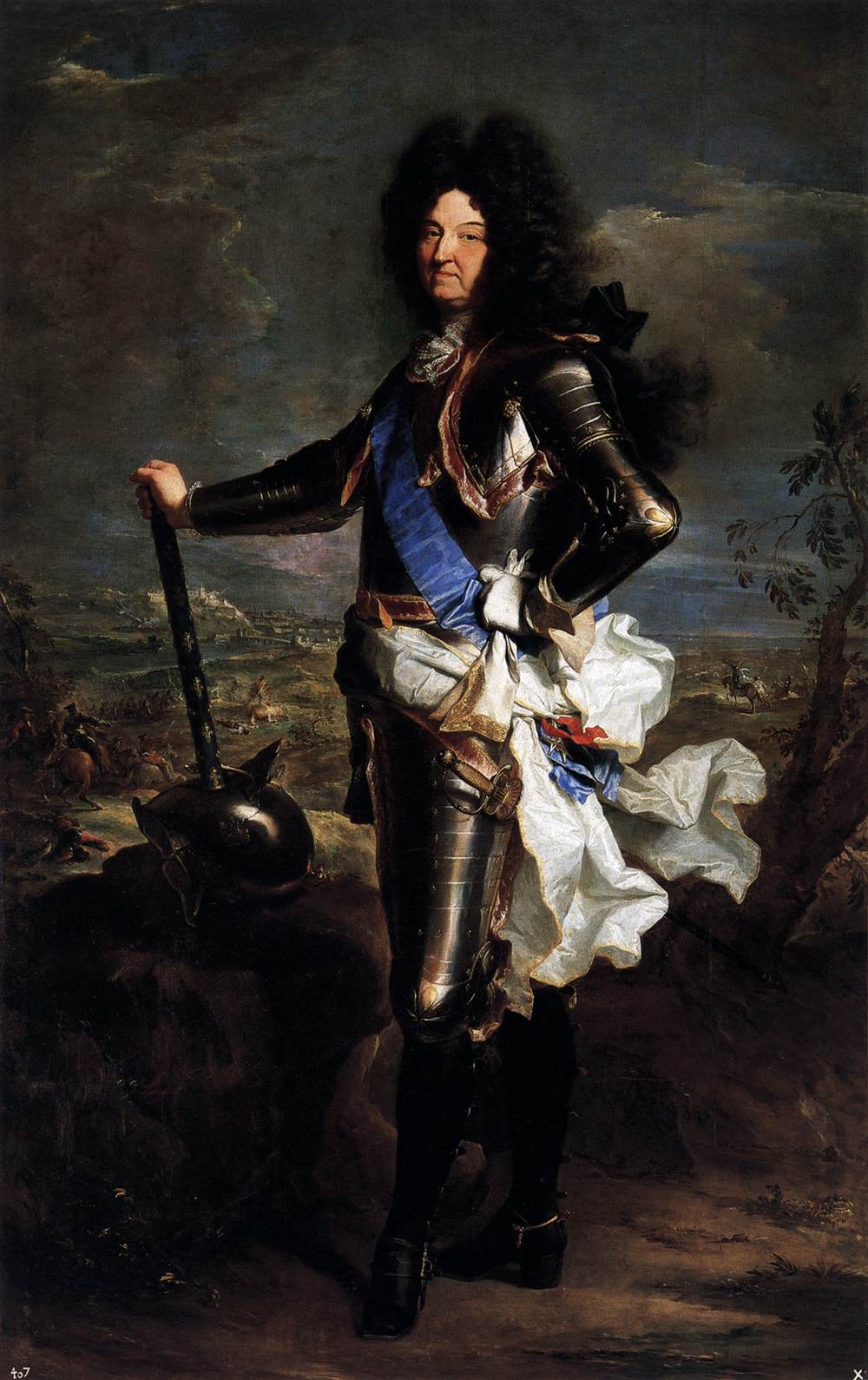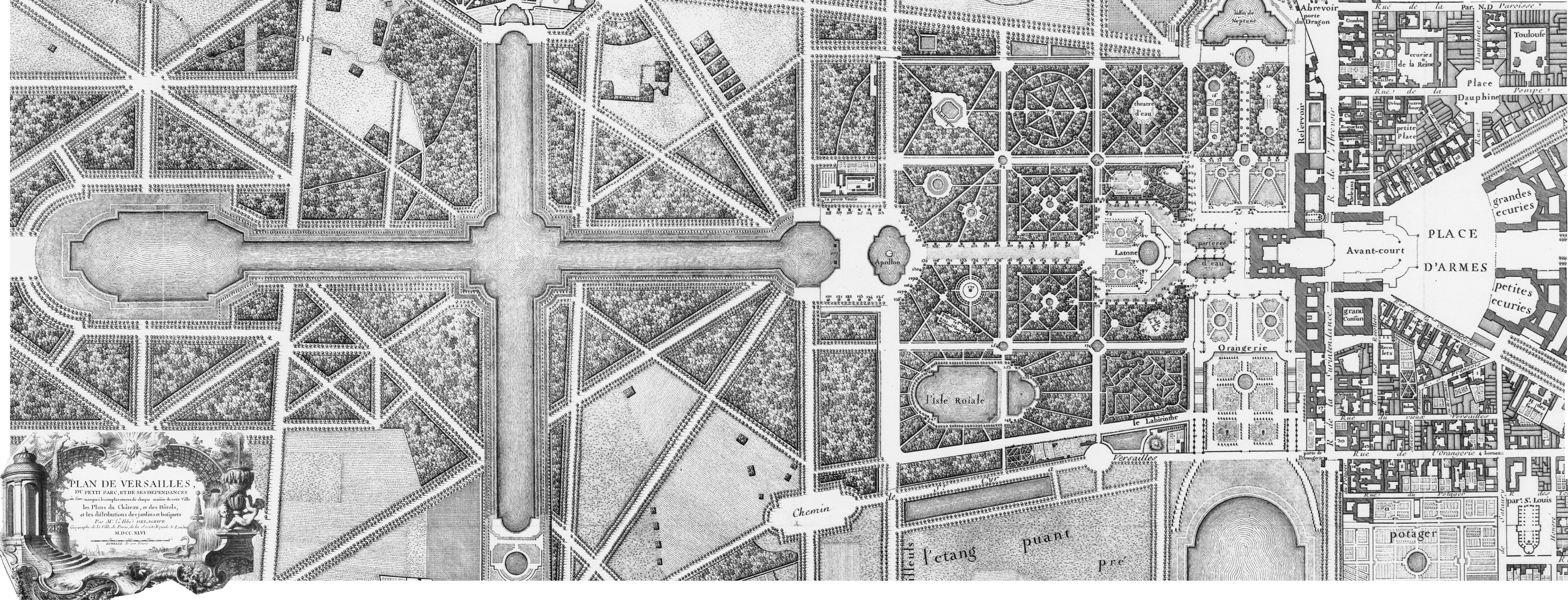Rigaud Hyacinthe's Louis XIV
By the efforts of 36,000 workers, Versailles was completed and stood as the symbol of Louis' absolute power and authority. There, he moved his government offices and court. Versailles became the unofficial capital of France.
Prior to Louis' rule, French nobility rebelled strongly against centralized government. They preferred provincial government and local aristocratic autonomy. Louis' father, Louis III, died during his childhood and Cardinal Mazarin assumed control until Louis XIV was of age. After a mob pursued Louis as he slept in the Louvre, his distrust of nobility was solidified. Louis shared the same goal as Cardinal Mazarin: dominance, but once he assumed the thrown, his tactics proved far more effective than his predecessor's. He amassed a well paid army and was extremely mindful of the regional parliaments, consulting with them at court often.
Louis XIV beckoned the Age of Absolutism-- an age in which almost every European court modeled itself on Louis XIV's court. He essentially drew them in to conquer them (he banned them from holding high government positions). Louis wielded authority over the French plebeians, the aristocracy, and the church-- as Absolutism implies, he had absolute, divine right to ruler ship (think ancient Egypt).
Lets take a look at his art

The Palace of Versailles in 1722
As we continue to witness, art of the past usually had utilitarian purposes, whether it be in the service of the Church or aristocracy (for art meant for pedestrians is seen only sparsely for most of history). The goal of the art Louis XIV commissioned was to declare his divine, absolute right, thus: Versailles had to be unequaled in ostentatious extravagance, scale and ornamentation. This was achieved.

Hall of Mirrors, Charles Le Brun and Jules Hardouin-Mansart
The Hall of Mirrors-- the tunnel that appears to never end. When bathed in light, its windows and mirrors extend the great space beyond its walls and your imagination. In a word: extravagant. Louis's accomplishments were displayed on the ceilings in paint (he was depicted as a Roman emperor). Talk about artisan ship-- talk about detail-- talk about ornamental lavishness-- talk about splendor.
The room was originally filled with solid silver tables, lamp holders, and potted orange trees. The glass came from Paris glass factories, created to compete with Venetian glass (Venice was famous for its glass factories at this time). This place dripped with the grandeur of Louis XIV's baroque tongue. Later, the objects that littered the space were melted down to finance Louis' war efforts.It is important to note that outside of these sickeningly wealthy walls, the pedestrians of France were starving. Louis's government did not address the threats of his people, namely: drought, famine, plague, and pestilence.
THE FRENCH BAROQUE GARDEN: Versailles's grounds boasted what is now known as the French Garden. The park of Versaille was designed by Andre Le Notre who transformed an entire forest into a park. Here is what is important to know:
they are methodically planned/geometrical in design/they manifest the rationality sought by Louis XIV
geometrical units were tightly arranged with focal points at their centers (like sculptures, pavilions, reflecting pools and fountains/ the design loosens the farther away you get from the palace/ trees frame or screen open views of the countryside
apparently, one must walk through the garden to understand its dynamic design/ the park unfolds itself to its visitors
Essentially, Louis XIV's commissioned Classical architecture (harmony/balance) on a Baroque scale (grandiose/monumental). French baroque architecture is often called Classical Baroque.
These opposing forces were not solely embodied in the harmonious melodies of the (French)Classical Baroque, but also in a cacophonous clash between two of the greatest artists of the period: The Classicist Poussin and the Baroque Rubens.
But before we get to them:
Thought Food:
- Where do you think the peasants were and what were they doing while Versailles was occupied?
- Living well?
- With all his time spent erecting his monarchical penis, do you think his kingdom was well kept?
- Does this effect the way you view his art and aesthetics? Might this effect the way you view French Baroque art?
- Philosophically, do you think Absolutism was an innate understanding in the people or was it forced upon them? Is more historical knowledge required to understand this?
Is it a symbol from a preferable or regrettable time in history?
Rubens v.s. Poussin
Rubens was a charming breed-- an international superstar. He was Flemish by birth but this hardly is telling of his aesthetic. What is telling is that he visited Italy where he studied the predecessors of the Baroque invention and its right holding innovators: the Renaissance Michelangelo and Titian and the Italian Baroque Caravaggio and Carracci. In consequence, his excursion was a branch in art history that is absolutely nonnegotiable in importance. Rubens synthesized his own style that was Pan-European.
Rubens created this masterpiece after his return from Italy to Flanders. What is revealed in this triptych is his interest in Italian aesthetics.
Notice: the tension and counter forces of the muscularity-- the strain in their arms as they let down the dead Christ. The contortion and foreshortened anatomy reminiscent of reminiscent of Michelangelo's paintings and sculptures. The energetic violence, physical and emotional distress, stressing sinew and anguished faces: parallel to Mannerism's transformation to Baroque. The colors of Titian. These bold colors and dramatic light would later give way to a subtler style. Baroque intimations: dynamic composition/diagonal sensuality.
The Mannerism of Bronzino and Michelangelo + the color and texture of the venetian school of Titian + the light and dark of Caravaggisiti = Rubens
Rubens consorted with and served the heavy weights. Among his clientelle: the court of Mantua, Charles I of England, and the Spanish government of Flanders-- not to mention, he was the grandson of Marie de' Medici. This relationship yielded a powerful series of 21 paintings in celebration of her life, including this famous doodle:
Depicted is Marie's arrival in France from Italy. She is en route to her marriage to King Henry IV. Fame flies above her, trumpeting her arrival. Neptune and his son Triton, accompanied by 3 water nymphs, emerge from the sea to greet her. France (the helmeted man wearing a fleur-de-lis robe) bows before her. Marie is nestled in a flourish of rich textures and colors (she was not known for her beauty).Arrival of Marie de Medici at Marseilles
Notice: The fleshy bodies of nymphs. These fleshy bodies are known as Rubenesque. Fleshy folds and drapes over their bodies with...freedom. They are sensual in a way that does not quite translate well into contemporary tastes. But you can tell that these ladies indulge in a sensual life-- in excess.
In the interest of length and attention span, Poussin and Baroque France will be picked up at a later date. Thank you for joining me. It appears that what is pretty is not often nice... Before we glorify the magnificent, maybe we should ask ourselves at who's expense it was created. More on this is on the way. Take care.
Arbiter






Arbiter, this is excellent work. I appreciate the thinking that has gone into uniting both sides of the question . . . the dark and the light, the good and the bad. I'm looking forward to the trip towards the 21st century. Next stop = The Enlightenment?
ReplyDelete